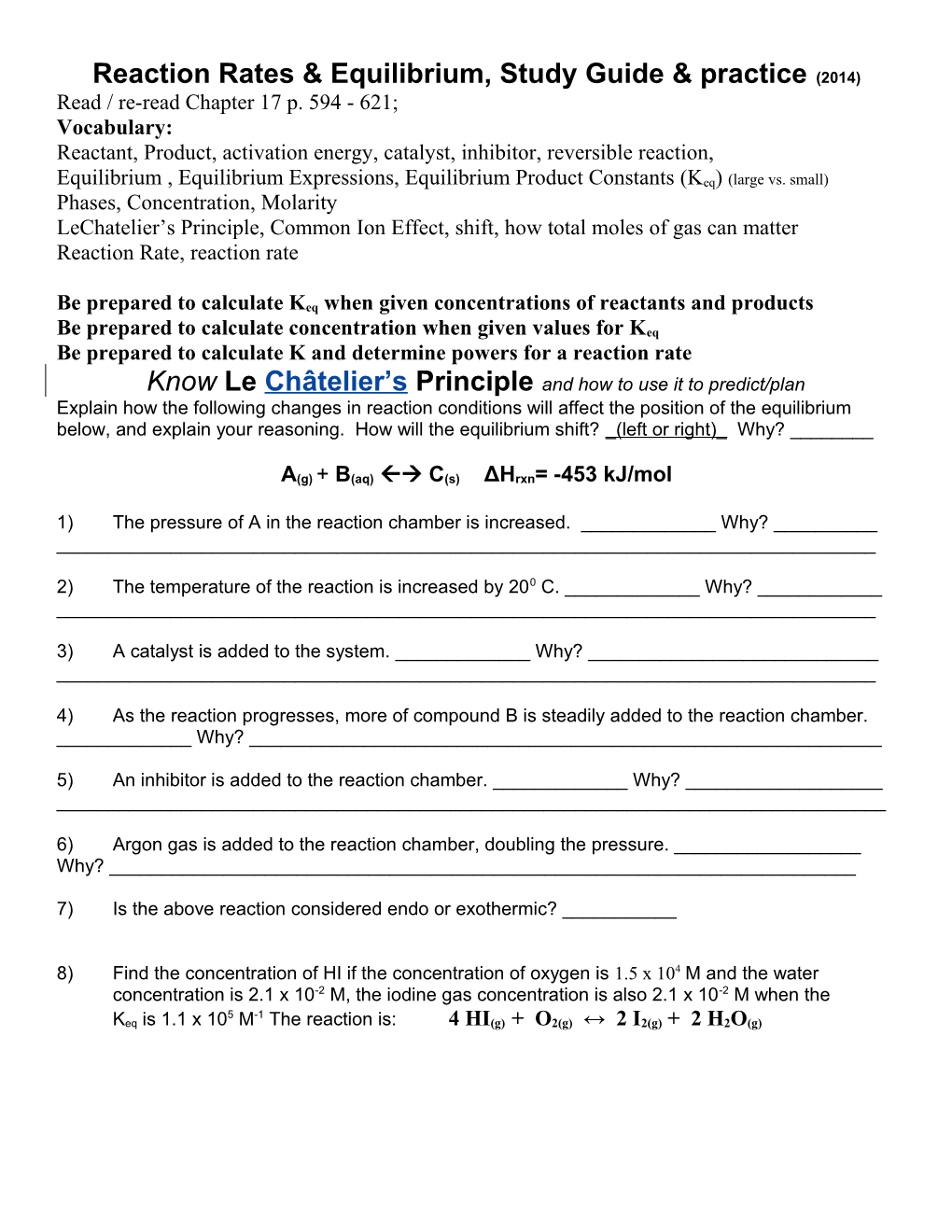Reaction Rates & Equilibrium, Study Guide & practice (2014)
Read / re-read Chapter 17 p. 594 - 621;
Vocabulary:
Reactant, Product, activation energy, catalyst, inhibitor, reversible reaction,
Equilibrium , Equilibrium Expressions, Equilibrium Product Constants (Keq) (large vs. small)
Phases, Concentration, Molarity
LeChatelier’s Principle, Common Ion Effect, shift, how total moles of gas can matter
Reaction Rate, reaction rate
Be prepared to calculate Keq when given concentrations of reactants and products
Be prepared to calculate concentration when given values for Keq
Be prepared to calculate K and determine powers for a reaction rate
Know Le Châtelier’s Principle and how to use it to predict/plan
Explain how the following changes in reaction conditions will affect the position of the equilibrium below, and explain your reasoning. How will the equilibrium shift? _(left or right)_ Why? ______
A(g) + B(aq) C(s) ΔHrxn= -453 kJ/mol
1)The pressure of A in the reaction chamber is increased. ______Why? ______
2)The temperature of the reaction is increased by 200 C. ______Why? ______
3)A catalyst is added to the system. ______Why? ______
4)As the reaction progresses, more of compound B is steadily added to the reaction chamber.
______Why? ______
5)An inhibitor is added to the reaction chamber. ______Why? ______
6)Argon gas is added to the reaction chamber, doubling the pressure. ______
Why? ______
7)Is the above reaction considered endo or exothermic? ______
8) Find the concentration of HI if the concentration of oxygen is 1.5 x 104 M and the water concentration is 2.1 x 10-2 M, the iodine gas concentration is also 2.1 x 10-2 M when the
Keq is 1.1 x 105 M-1 The reaction is: 4 HI(g) + O2(g) ↔ 2 I2(g) + 2 H2O(g)
9)Find the rate law expression for the following (The rate = k [A]x[B]y expression with k, x and y filled in) :
3A + 2B --> C + 2DExperiment / [A] / [B] / Rate (M/min)
1 / 0.15 / 0.10 / 0.000670
2 / 0.15 / 0.20 / 0.002690
3 / 0.05 / 0.10 / 0.000074
4 / 0.30 / 0.30 / 0.024300
10)Draw a graph of concentration over time (or reaction progress) for this reaction:
3 H2(g) + N2(g) ↔ 2 NH3(g)
Answers
1)The pressure of A in the reaction chamber is increased.
The reaction is pushed toward products.
2)The temperature of the reaction is increased by 200 C.
Because heat can be thought of as being a product, the reaction will be pushed toward reactants.
3)A catalyst is added to the system.
No change. A catalyst doesn’t change the equilibrium position; it only changes how quickly equilibrium is reached.
4)As the reaction progresses, more of compound B is steadily added to the reaction chamber.
The reaction is pushed toward products.
5)An inhibitor is added to the reaction chamber.
No change, though the reaction will move more slowly.
6)Argon gas is added to the reaction chamber, doubling the pressure.
No change. If the partial pressure of gaseous compounds is changed, the equilibrium will shift position. However, adding argon gas doesn’t change the partial pressures of A, so the equilibrium position is unaffected
7)The change in enthalpy (DH) is negative so the reaction gives off energy or is EXOTHERMIC (heat is a product)
8)[HI]4 = 1.2 x 10-16 M4 (raise to the ¼ power) [HI] = 1.0 x 10-4 M
9)Rate = 3 M-3 min-1 [A]2 [B]2
10)
Concentration graph:
